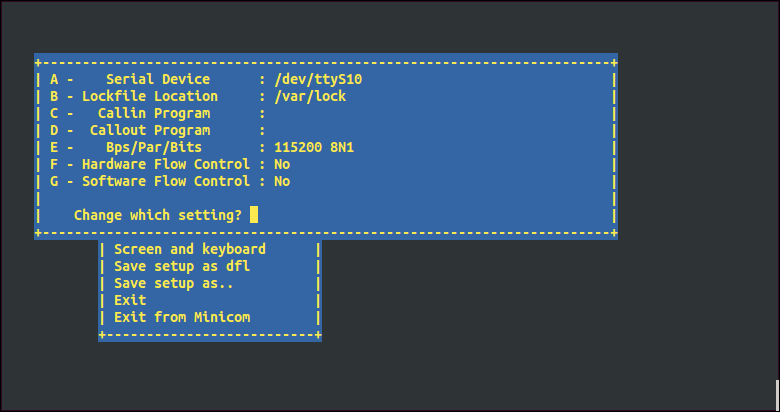Getting Started With Minicom
Contents
Background
minicom is a serial communication program that connects to devices through a GNU/Linux PC's serial ports. If run by calling its name without any additional arguments, it uses whatever settings have been saved for its defaults in /etc/minicom/minirc.dfl. For those using a Windows, PuTTY is a great application to make such connections between a Windows PC and one of our EMAC devices. More information about PuTTY can be found at http://wiki.emacinc.com/wiki/PuTTY.
General Information
The use of minicom is required when connecting an EMAC board for testing purposes. This pages sets out to provide general information about using minicom to communicate between EMAC devices and your development PC.
Getting Started With Minicom
-
If
minicomhas yet to be installed on your Linux machine, useapt-getto install theminicompackageuser@developerpc:~#sudo apt-get install minicom -
The
minicomsettings will need to be changed so that the application will be able to find your device. Pull up the settings using the-soption.user@developerpc:~#sudo minicom -s
This should bring up a colorful display listing the different settings. If the display isn't colored, arrow down to Exit from Minicom. Run the
minicomcommand with the options-scon. Thecspecifies the color display andontellsminicomto display the interface in color.minicomcan be made to always run in color by modifying the~/.bashrcfile and settingminicomto alias tominicom -con.
-
The first thing that will need to be configured is the Serial port setup. Arrow down to the title and press the 'Enter' key.
-
To modify the different configurations, press the key corresponding to the setting. For example, press the 'A' key to modify the path to the Serial Device. Press the 'Enter' key to save the parameters for the setting. The settings for specific EMAC devices can be found at the Serial Connectoins page.

In this screenshot, the "115200 8N1" for the Bps/Par/Bits setting indicates the baud rate is set to 115200, data bits set to 8 (the '8' in 8N1), parity is set to none (the 'N' in 8N1), and stop bits is set to 1 (the '1' in 8N1). If you're likely to use the same serial port when connecting to your device with minicom, modify the Serial Device setting to have the path to the port. This way, you'll be able to run the command without any options or commands. Press the 'Esc' key to be be brought back to the configurations page.
-
The next setting that needs to be configured is the Modem and dialing. Press the 'A' key and delete its content. Hit the 'Enter' key to set the setting as blank. Do this for B-K, and H. Hit the 'Esc' key when finished deleting the content of these settings.
-
That's all the modifications that need to be done to get
minicomset up. Arrow down to Save setup as dfl and press 'Enter'. If a message pops up saying "cannot write to /etc/minicom/minirc.dfl", you likely aren't running the command as root. Re-run the command withsudo. -
Once you're able to save the configurations, arrow down to Exit from Minicom.
Running Minicom
Now that everything is configured, let's make the connection to the device.
-
Run the
minicomcommand with the option-Dand the path to the device as an argument.user@developerpc:~#minicom -D /dev/ttyS10If the path to the device is what you have configured in the
minicomsettings, you won't need to use the-D /dev/ttyS10arguments and options./dev/ttyS10is just an example of a path to a serial port; your path may be different. Using the-ooption will allowminicomto make the connection more quickly by not sending AT commands to initialize a modem. -
Log in with the appropriate username and password for the device. Log in information can be found at here. You're now able to communicate to the device and use
minicomin the same way as using the terminal for the device.
Conclusion
This program is a very powerful tool for developers. While functioning largely as a terminal for the connected device, it also can be be used to view important output form other system functions like when the system starts up or reboots.
Further Information
Where to Go Next